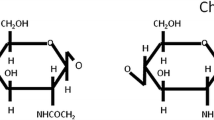Abstract
Shelf-life extension of aquatic products is of significant economical importance. To determine the potential effect of chitosan on the shelf-life of filleted tilapia, this study analyzed the bacterial community diversity in fresh and spoiled tilapia fillets stored at (4 ± 1)°C and examined the antimicrobial activity of chitosan against relevant bacteria isolates. Results showed that Pseudomonas (20%) and Aeromonas (16%) were abundant in fresh tilapia fillets, whereas Pseudomonas (52%), Aeromonas (32%) and Staphylococcus (12%) were dominant in the spoiled samples. Chitosan showed wide-spectrum antibacterial activity against bacteria isolated from tilapia and 5.0 g L−1 chitosan was selected for application in preservation. We further determined the shelf-life of chitosan-treated, filleted tilapia stored at (4 ± 1)°C based on microbiological, biochemical and sensory analyses. Results showed that the shelf-life of chitosan-treated, filleted tilapia was extended to 12 d, whereas that of untreated, control samples was 6 d. These indicate that chitosan, as a natural preservative, has great application potential in the shelf-life extension of tilapia fillets.
Similar content being viewed by others
References
Ababouch, L. H., Souibri L., Rhaliby, K., Ouahdi, O., Battal, M., and Busta, F. F., 1996. Quality changes in sardines (Sardina pilchardus) stored in ice and at ambient temperature. Food Microbiology, 13: 123–132.
Al-Harbi, A. H. and Uddin, N., 2005. Bacterial diversity of tilapia (Oreochromis niloticus) cultured in brackish water in Saudi Arabia. Aquaculture, 250: 566–572.
Amerine, M. A., Pangborn, R. V., and Roessler, E. B., 1965. Principles of sensory evaluation of food. Academic Press, New York, USA, 602pp.
Banks, H., Nickelson, R., and Finne, G., 1980. Shelf life studies on carbon dioxide packaged finfish from Gulf of Mexico. Journal of Food Science, 45: 157–162.
Cao, R., Xue, C. H, Liu, Q., and Yin, B. Z., 2009. Microbiological, chemical and sensory assessment of (I) whole ungutted, (II) whole gutted and (III) filleted tilapia (Oreochromis niloticus) during refrigerated storage. International Journal of Food Science and Technology, 44(11): 2243–224
Chung, Y. C., Wang, H. L., Chen, Y. M., and Li, S. L., 2003. Effect of abiotic factors on the antibacterial activity of chitosan against waterborne pathogens. Bioresource Technology, 88: 179–184.
Connell, J. J., 1990. Control of Fish Quality. Fishing News Books Ltd, Oxford, 227pp.
Bagge-Ravn, D., Ng, Y., Hjelm, M., Christiansen, J. N., Johansen, C., and Gram, L., 2003. The microbial ecology of processing equipment in different fish industries — analysis of the microflora during processing and following cleaning and disinfection. International Journal of Food Microbiology, 87: 239–250.
Fernandez-Saiz, P., Soler, C., Lagaron, J. M., and Ocio, M. J., 2010. Effects of chitosan films on the growth of Listeria monocytogenes, Staphylococcus aureus and Salmonella spp. in laboratory media and in fish soup. International Journal of Food Microbiology, 137: 287–294.
Friedman, M. and Juneja, V. K., 2010. Review of Antimicrobial and Antioxidative Activities of Chitosans in Food. Journal of Food Protection, 73(9): 1737–1761.
Gelman, A., Glatman, L., Drabkin, V., and Harpaz, S., 2001. Effects of storage temperature and preservative treatment on shelf life of the pond-raised freshwater fish, silver perch (Bidyanus bidyanus). Jounal of Food Protection, 64: 1584–1591.
Gennari, M., Tomaselli, S., and Cotrona, V., 1999. The microflora of fresh and spoiled sardines (Sardina pilchardus) caught in Adriatic (Mediterranean) Sea and stored in ice. Journal of Food Microbiology, 16: 15–28.
Gram, L. and Huss, H. H., 1996. Microbiological spoilage of fish and fish products. International Journal of Food Microbiology, 33: 121–137.
Gram, L., Wedell-Neergaard, C., and Huss, H. H., 1990. The bacteriology of fresh and spoiling Lake Victorian Nile perch (Lates niloticus). International Journal of Food Microbiology, 10: 303–316.
Holt, J. G., Krieg, N. R., Sneath, P. H. A., Staley, J. T., and Wiilliams, S. T., 1994. Bergey’s Manual of Determinative Bacteriology, 9th edition. Williams and Wilkins, Baltimore, 787pp.
Hultin, H. O., 1985. Characteristics of muscle tissue. In: Food Chemistry. Fennema, O. R. ed. Marcel Dekker Inc, New York, USA, 725–789.
Huss, H. H., 1995. Quality and quality changes in fresh fish. FAO Fisheries Technical Paper 348. FAO, Rome, 423pp.
Lakshmanan, P. T., 2000. Fish spoilage and quality assessment. In: Quality assurance in seafood processing. Iyer, T. S. G., Kandoran, M. K., Thomas, M., and Mathew, P. T. eds. Society of Fisheries Technologists, Cochin, India, 26–40.
Nedohula, P. C. and Westhoff, D., 1997. Microbiological analysis of striped bass grown in three aquaculture systems. Food Microbiology, 14: 255–264.
Raafat, D. and Sahl, H. G., 2009. Chitosan and its antimicrobial potential — a critical literature survey. Microbial Biotechnology, 2(2): 186–201.
Rabea, E. I., Badawy, E. T., Stevens, C. V., Smagghe, G., and Steurbaut, W., 2003. Chitosan as Antimicrobial Agent: Applications and Mode of Action. Biomacromolecules, 4(6): 1457–1465.
Savvaidis, I. N., Skandamis, P. N., Riganakos, K. A., Panagiotakis, N., and Kontominas, M. G., 2002. Control of natural microbial flora and Listeria monocytogenes in vacuumpackaged trout at 4 and 10°C using irradiation. Journal of Food Protection, 65: 515–522.
Simeonidou, S., Govaris, A., and Vareltzis, K., 1998. Quality assessement of seven Mediterranean fish species during storage on ice. Food Research International, 30: 479–484.
Sudarshan, N. R., Hoover, D. G., and Knorr, D. G., 1992. Antibacterial action of chitosan. Food Biotechnology, 6(3): 257–272.
Tejada, M. and Huidobro, A., 2002. Quality of farmed gilthead seabream (Sparus aurata) during ice storage related to the slaughter method and gutting. European Food Research and Technology, 215: 1–7.
Wang, G. H., 1992. Inhibition and inactivation of five species of foodborne pathogens by chitosan. Journal of Food Protection, 55: 916–919.
Author information
Authors and Affiliations
Corresponding author
Rights and permissions
About this article
Cite this article
Cao, R., Liu, Q., Yin, B. et al. Chitosan extends the shelf-life of filleted tilapia (Oreochromis niloticus) during refrigerated storage. J. Ocean Univ. China 11, 408–412 (2012). https://doi.org/10.1007/s11802-012-1923-9
Received:
Revised:
Accepted:
Published:
Issue Date:
DOI: https://doi.org/10.1007/s11802-012-1923-9




